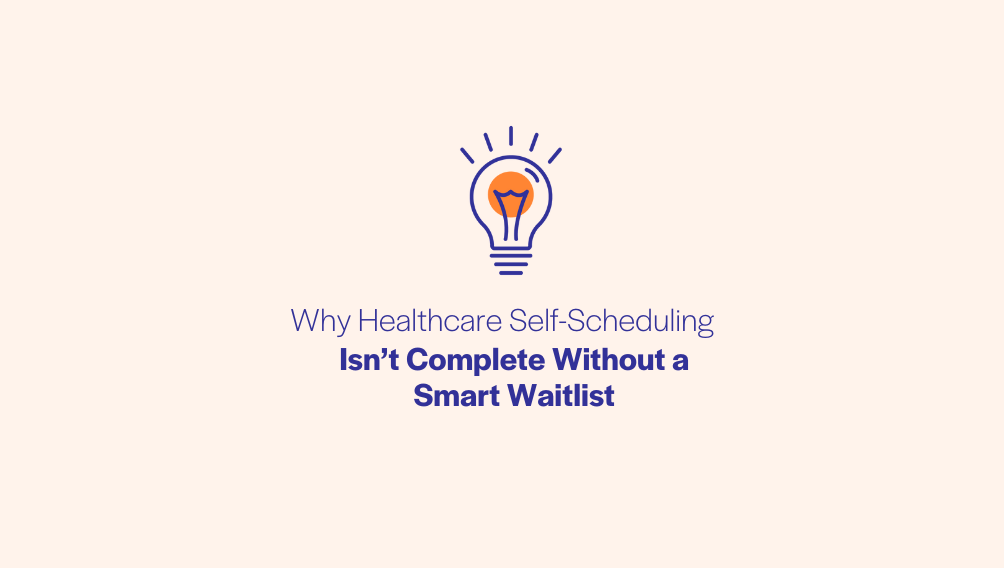Why Healthcare Self-Scheduling Isn’t Complete Without a Smart Waitlist

Even if you’ve invested in patient self-scheduling, your staff and patients might be faced with challenges that impact your schedule. Patients often book appointments weeks or months in advance, only to meet life’s curveballs that force them to cancel when appointment day draws near. Without an automated system to address these sudden openings, the only way to fill them is hours of manual calls by staff. Manual outreach to one patient at a time is inefficient and unsustainable – leading to holes in the schedule and lost revenue.
The Gap Left Without an Automated Waitlist
Patient self-scheduling is a huge benefit to patients and health systems, because it frees up staff time while giving patients more control and convenience. But if something changes, how does your organization match patients with sooner slots that they might be waiting for?
Without an automated waitlist, staff are forced to choose between leaving a last-minute opening unfilled or calling one patient at a time to try to fill it. Staff often don’t have the bandwidth for these manual calls – which could take hours – or to keep track of which patients might want an earlier appointment and which slots have newly opened up.
Meanwhile, patients who would eagerly take that newly opened slot never get the call at the right time, and providers’ valuable time goes unused.
The Smart Waitlist: How It Complements Patient Self-Scheduling
A smart waitlist solves the puzzle that self-scheduling alone can’t fix. Unlike a static waitlist scribbled on a sticky note or stored in a spreadsheet, a smart waitlist integrates directly with your EHR schedule. Patients interested in moving up their appointments add themselves to the waitlist. When a slot opens, the system automatically identifies which patients are waiting and offers the slot to them.
Even better, a smart waitlist integrated with your EHR schedule will match patients’ appointments and available offers – so patients receive only offers for the same appointment, duration, and even provider as the appointment they already have scheduled.
A good waitlist uses smart logic, EHR integration, and patient messaging to seamlessly fill open slots on your schedule – all without staff needing to lift a finger.
How a Smart Waitlist Works in Practice
Consider a scenario where a dermatology practice stays booked out for months. Patients schedule far in advance; many would love to move into an earlier slot if it became available. With a smart waitlist, patients who want earlier timeslots enroll themselves easily. When a cancellation appears, the system reviews the waitlist, identifies patients who are eligible for that appointment based on preferences and appointment type, and sends an SMS notification offering the newly opened time. Patients confirm with a simple reply, and the slot is booked in seconds with no frantic phone calls, guessing games, or lengthy delays.
Patients benefit because they’re seen sooner. Providers benefit because fewer appointment times goes to waste. Staff benefit because they avoid chasing patients manually. And the practice benefits with happier patients and providers and more appointment revenue.
Combining Self-Scheduling and a Smart Waitlist for Optimal Results
The most effective patient access strategy integrates self-scheduling and a smart waitlist into one cohesive system. Self-scheduling creates an accessible entry point for patients—booking appointments on their own terms, no matter the time of day. Meanwhile, the smart waitlist captures cancellations, moves patients up, and ensures that patients get the care they need as soon as possible.
Healthcare scheduling continues to evolve, and organizations that embrace innovative, integrated tools stand to gain the most. Self-scheduling marks a big step forward, but a truly complete solution adds the power of a smart waitlist. This combination keeps patients engaged, supports staff, and ensures every appointment slot serves its purpose.
Luma offers a platform that brings these elements together seamlessly. With Luma’s patient scheduling solutions, healthcare providers integrate self-scheduling and a smart waitlist within a single, user-friendly interface. Patients find securing the care they need easier, and providers stay more productive, efficient, and adaptable.
A modern approach to healthcare access shouldn’t leave anyone waiting indefinitely. A smart waitlist elevates self-scheduling to a new level of effectiveness by creating a patient experience that feels responsive and less complicated. Embrace Luma’s patient access tools to transform how your organization manages appointments.Click here to book a demo and see how it works today.